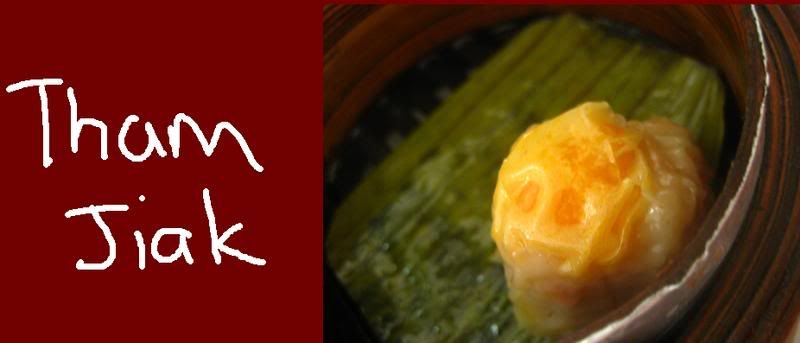Saturday, January 15, 2011
Newember
Saturday, November 10, 2007
Apples & Thyme

It had been a long time since I last join a food event, but this time it got me out of my cold storage box again, just because the theme really got me at my heart. This event is about, quoting african vanielje, celebrations of mothers and grandmothers and time spent with them in the kitchen, in dedication to Jeni’s mother. Apples and Thymes, it seems like the perfect name for the theme today, though I cannot explain why.
If you are a regular reader of my blog, you would have read bout my stories about my Ah Ma (grandmother) in so many occasions. For Ah Ma, the ever diligent wife, mother and grandmother, the always seeking of self improvement, the only bind now to our big family tree, the reason we all should appreciate and celebrate life and the ties to our roots back to China itself. I bet these reasons are truly strong enough for a celebration, a big one at date. So let’s toast to my Ah Ma and all the mothers and grandmothers in the world. You all somehow make this world a better place.
Looking back, it seems that I did not spend enough time with my Ah ma in my earlier days. What a shame, I certainly could have learned a lot. It was not until I went to Kuala Lumpur, the capital of Malaysia, to study and now to work, that I learn what I have all these while been taking for granted – real food laboured with real love. Maybe it is also our Asian way of life, where kids are not allowed to play in the kitchen; too dangerous, too troublesome, going to cut self with knife, breakables would be broken, edibles made inedible and the list would go on. That is how then, this little Chinese kid got left out of her Ah Ma’s kitchen, much to her lament.
But I remember the festivals, the time where we (kids) just might have the reason, or rather the chance to help out in the kitchen. I remember once, during Tanglung (Lantern) festival, I don’t know why this event was etched firmly in my memory where I can picture it vividly in my mind, where my sister and I walked into the kitchen where there were hundreds of mini Tong Yuens (glutinuous rice dumplings balls) in plethora of pinks, whites, greens and yellows in a huge metal tray. Ah Ma’s version of Tong Yuen is more of the north Malaysia style, small and plain with no fillings. My sister and I would eagerly help to shape the balls. I still remember Ah Ma saying, “Aiya, not like that, one big one small. Aiya, not round enough, let me show you”. She then will show her spectacular skill of rolling Tong Yuen into a round ball at the right size at amazing speed, due to years of making of thousands of them. Although she would try her best to advise us, we end up with Tong Yuens of various sizes and some oval, some round, some flat. In the end, she would still smile, praise us for our help and then throw it all in boil and then add into the prepared sweet ginger soup. I found a video here at Malaysia Best, where there are two little boys helping out with making Tong Yuen.
Anyhow, after I went to the big world out there, I do also always try to return to my little hometown, where every time I would bombard my Ah Ma with various questions on how she make this or that dish. Just like every cook, especially the ones who enjoy it, she would go into a long and detail description from picking of the right vegetables to the right cut of meat, then to right preparations and the many seasonings up to the right way of cooking and down to the right time itself. I would sit there fixated, nodding occasionally and try to absorb everything. Sometimes when the list got too long, I might whip out my PDA or a paper to note things down. When I got home again, I would try to replicate some of dishes that I learned, mostly a success as Chinese cooking when once you understand its basics and have spent years in eating them, you can easily make it, but mostly it is never up to par to Ah Ma. Maybe in the future, after years of practice, I might make it as good as her.
Although there were many of her dishes that I loved, there was one dish that I hold really dearly to my heart personally. This one dish that I always beg her to make is ho lan shu chu yok (stir fry potato and pork in dark soy sauce). Whenever she cooks this dish is I would be eating and eating it way after I finish off my rice. I would have to pry myself from the table in risk of finishing it before anyone else can have the chance to eat it. Then, after a while off, I would then pester her again, “Ah Ma, when are you going to cook potato chu yok (this mixed term was coined since I was really young) again?”. She would then just smile and ask if I am ever bored at it, which I would shook my head vigorously. Even after long gone from home and back again, I once again request for this comfort dish of mine. I am so excited when we finally cook it together in her kitchen; after all I am not a kid anymore right, where I would be more of a help than a nuisance, then again, arming with camera in hand, I do seem worst off, but a food blogger got to do, what she got to do – shoot!
Wednesday, October 10, 2007
One-nine-eight-four: Ra-ta-too-ee
1984 is the year we are all born in. It is the year of the Golden Rat, for the Chinese. All of us actually got together during our teens, when somehow we find commonness among ourselves. As my grandmother taught me long time ago when I was just a little kid, “birds of a feather, flock together”; I did not know then that this quote would apply to me personally as well as anywhere in this world (read the news and you know what I’m talking about) so well. But after we graduated from high school, we all started to grow different feathers, inevitably moving towards very different directions. Out of sentiments I guess, up till now, we are all still trying our very best to keep in touch, maybe once a while flock together.
I had just deleted a paragraph that I wrote about us, our timelines and so forth. Why? I feel that it would bore you readers with too much detail. Then I remembered a story I written quite long ago, at the time when we were in the midst of nearly breaking apart, to metaphorically describe 1984’s and my journey thus far:
The One Behind
Walking down the road, she turned and stared at the distant. She shields her eyes from the glaring sun. She squinted to see it. She knew that it is there. After some time, her eyes adjusted, and she can see the beautiful house, seemingly shining among the sky. Her eyes watered from the strained, yet she continues to stare. Giving a final look, she turned and went on her way.
The road in front of her would be long. It would be certainly different from the comfort life in the house. But she knew she had to move on. She had to walk this path, in order to fulfill her destiny. It is inevitably part of her life’s scheme. But yet she knew the life she once had in the house will always be in her heart.
As she moved along the road, her perspective of it seemed to change. When she left the house, the road seems narrow, rocky and steep. It seemed really hard to tread it. Yet now as days go by, the road seems bigger, wider, leveled and smoother. Her feet, once dragging on had begun to start walking. As she walked on, it started to skip along. The road now seems very enjoyable.
As she was walking down the road, the house is still in sight right behind her. It is always there for if ever once, she stumbled and fell, and she can always turn back and see that support is there, just within reach. Once a while, she did tripped and she did fumbled on the rocks on the road. And every time, with knees and hands on the floor she would look back and be reassured by the sight of the house and then with renewed strength, she would once again stand up and resumed her walk.
As days goes by, she learnt to skip the rocks, she learn to look for holes and she learn to tread with care. She had found walking the road so much easier. Along the way, she found more things to do, other sights to behold, flowers to be picked, sceneries to be enjoyed and wonderful breeze to revel in. Thus, she was so caught up with all these pleasures in walking down the road, the house seemed like a distant fading picture.
But soon she realizes something is missing. She enjoyed the sights. She loved the smell of the flowers. She stood in awe of the sceneries and she got swept away by the cooling breeze. Yet she knows she would not be here enjoying all these if it wasn’t for the house. So she stopped in her tracks; and once again turn back to look at the house, this time not for assurance, but just because.
She smiled, as the house still stood looming there, shining before the bright sky. This time, the sun did not even seem to bother her. With the image in her mind, etched deep in her memories, she returns to continue down her path. This time, there is even more spring in her steps.
 Ratatouille (ra-ta-too-ee)
Ratatouille (ra-ta-too-ee)Adapted from Flavours (Sept-Oct 07 Issue)
Since I was privileged as a cook, I had my friend to do the grocery shopping for me. I had sent them the needed ingredients prior to this. Imagine, halfway between their shopping they called me up and ask me what the heck is zucchini? I laughed and told them to skip it then if they can’t find it. They also asked where to get rosemary (I was thinking of the vacuum-packed fresh ones), I tried to explain where to get it in Tesco but finally they end up buying me bottled dried rosemary. Then besides, they overlook the ingredient of canned tomato puree which is essential to this recipe. Oh well, I have to make do with what I have and improvise.
Therefore I ration some of the fresh tomatoes out and made my own tomato puree. I found that do not need to simmer for 1 hour (as per original recipe) as I see that everything is well cooked and the eggplant is starting to turn black and soft. Maybe because I altered the amount of tomato puree, I’m not sure why though. So use your own judgment when you cook it. The recipes also states that it will develop taste overnight but we can’t wait eh, we are having party! It tastes great nevertheless, with convictions from my friends.
2 long purple eggplant
salt for sprinkling
2-3 tablespoons olive oil
1 onion, cut into cubes
1 red capsicum, seeded and cubed
1 green capsicum, seeded and cubed
3 cloves garlic, chopped
150g tomatoes, peeled and cubed
1-2 tbsp dried rosemary
sugar to taste
salt
handful of black olives, seeded and chopped
Tomato puree:
50g tomatoes chopped finely
Salt to taste
Sugar to taste
3 tbsp of tomato sauce
Mixed herbs
Preparation:
Split the eggplant lengthwise and sprinkle with salt to draw out bitterness. Set aside for 30 minutes, drain and cut into 2cm cubes
Prepare the rest of the ingredients as per above
For the tomato puree:
Sauté the tomatoes till soft, adding in salt and sugar to taste.
Smash the tomatoes while cooking it.
Then add in tomato sauce and sprinkle liberally with mixed herbs
Cooked till semi-dry and remove from pan then set aside
For ratatouille:
Heat the oil in a heavy-bottomed or cast iron pan. Add the eggplant and cook until lightly browned. Remove and set aside.
In the same pan, cook the onion (add more oil if necessary) until translucent. Add the red and green capsicums and cook until tender; add garlic, eggplant, zucchini, tomato and tomato puree. Cook for 1 minute.
Sprinkle in the dried rosemary liberally as well. Then add in the olives.
Simmer over low heat for 10 minutes.
Season to taste with sugar and salt, but I find it unnecessary since my home-made tomato puree is already very well seasoned.
Serve immediately to a table of 10 hungry girls
Saturday, July 15, 2006
It's Getting Hot in Here
Anyway, this time I am here to post for Barbara’s The Spice is Right Event, this time with the theme ‘It’s too darn hot!’ Barbara is so right about the case that we Asian love to eat hot and spicy food even though it is darn hot out there. Why? We are mad people who like to sweat their shirt out in some road-side stall with the heat up to 38 degrees. We also like to burn our tongues when we eat and end up with red puffy lips all day. We also happens to enjoy end up with a burning sensation in our stomach all day long and maybe a big business trip to the toilet. Well, there are many reasons we Asian eats darn hot chillies in the heat, but one holds true for everyone is that it is just plain good eats.
The chili condiment that I am going to feature today is called the Sambal Chilli. It is usually served alongside the famous local dish called nasi lemak, which is the unofficial Malaysia national dish, competing with char kuey teow. Nasi lemak holds much stronger position to me as it is enjoyed by all races, young or old. Somehow I believe that it evolves from a simple Malay dish to various types of serving, somehow adapted by other cultures. There are Indian and Chinese serving nasi lemak here in Malaysia, both with their own distinctiveness, or maybe not, what is real nasi lemak anymore anyway? The basic is the rice that is cooked in coconut milk and pandan leaves for fragrance. For now there are two popular types, one which is in small servings wrapped in banana leaves, the usual breakfast fare for our locals here. As for the bigger serving style, of huge amount of lemak (fatty) rice, and lots of sambal to go with it along with some fried ikan bilis (anchovies), groundnuts and cucumbers, sometimes with egg, hardboiled or sunny-side-up and fried chicken. This is the usual mamak style fare that we eat it anytime of the day, which I called it fast food the Malaysian style.
For me, as I grew up in Taiping, with not much of wondering around and not much of mamak stalls available, I have not been really expose to the wonders of nasi lemak. When I then came to KL I started to try it out both the breakfast and the mamak style. To me, the best of the nasi lemak comes not only from the coconut milk rice, but the sambal that goes with it. It must be hot with enough kick, while slightly sweet and tangy. Now I would share with you one fool-proof and darn hot
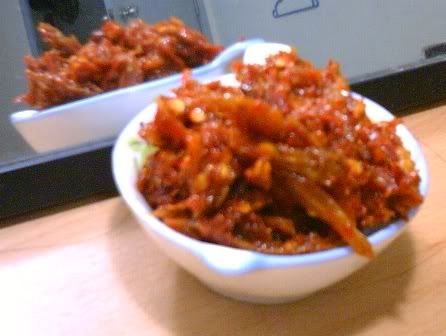
I got this recipe from KC, and it yields quite a large portion of sambal, thus I had scaled it down by half when I did it. But if you have a large family to feed, I would definitely recommend you to make the whole batch since you are doing the same amount of job and it keeps really well too. According to Gina (founder of KC and the one who shared this recipe) it can last for 1 month in room temperature (away from sunlight), 2 months in the fridge and 6 months or longer in the freezer! How cool is that? As for me, after eating bout half the batch, I took the liberty by adding fried ikan bilis (anchovies) to it for the nasi-lemak-style sambal which I’m not sure would the shelf life be shorten, but I remembered keeping it for quite sometime in the fridge. As the recipe that follows, most of the ingredients are just for guidelines, you can add more or less of whichever fancy you most. I had also reduced the sugar amount as I like my sambal more hot than sweet. Amount of oil is also adjustable, some like their sambal drowning in it, but as for me, I am a little health (or weight ha-ha) conscious, thus I reduced the oil amount quite a bit and it still turn out great.
100g red chilli
2 pcs of assam keluk/gelugor (tamarind slice)
100g sugar
10 shallots
6 cloves of garlic
250ml tamarind pulp juice (or dilute tamarind paste in hot water)
80ml oil
2 lime, juiced
Grind together the chillies, onions and garlic into a smooth paste
Add in sugar, tamarind juice and assam keluk to mix
Heat up the oil in the wok
Add in the chilli paste to cook, turning down to low heat and continue to stir fry the paste
Cook until the paste turns dark and starting to dry out
Turn off the heat and let it cool completely
Stir in the lime juice
Store in tight jars
For sambal ikan bilis:
2-3 handfuls of ikan bilis (anchovies)
Oil for frying
Heat enough oil for frying in the wok
When smoking hot, throw in the ikan bilis and fry until crispy
Take care not to burn it as it can turn from crispy to burn pretty fast
Dish out and let drain
Then stir it into the sambal, mix well
Store in tight jars again
Yields 300g of darn hot sambal
Suggestions:
Serve with nasi lemak
Goes along really well with stir-fry noodles too like my pad thai
Kicks up a notch on any regular or chinese fried rice
Leave out the ikan bilis to go with char kuey teow
Sunday, July 02, 2006
Going Thai
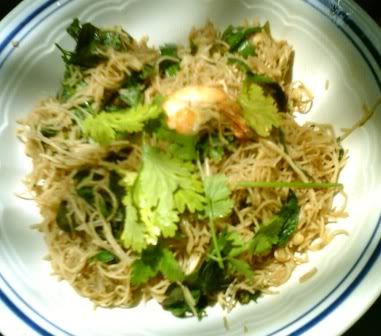
But this time, as per recipe I would be cooking it slightly at the end and then garnish it with more parsley. This dish also features a lot on the limau purut (kaffir lime leaves) which I had blog before on of those long-time-ago herb blogging. This time I am making a dish from the Thai cuisine. Thai is one of my favourite Asian cuisines, apart from Chinese and Indian, and also not to mention Vietnam. Thai is famous for its sweet, sour and spicy cuisine, complex in taste yet light on the palate.
So since these are my last few days of freedom, and usually being alone during the day, I decided to whip up a light lunch. Flipping through the recipes, I was drawn towards making my very own

I remembered having this dish before but I cannot recall where. Nevertheless, I know it would be good, as reading the ingredients made my mouth water. This dish can be chow (fried) with other meats such as chicken or beef but this time I am using prawns, since Tesco is having a huge sale on prawns, and it seem to be more authentic this way. Then of course there must be the fish sauce, which is the main flavouring agent in this dish. You can also substitute it with soy sauce, if you don’t have it. Oh ya, I wanted to get glass noodles for this, but I cannot seem to find it in Tesco, thus I bought brown rice vermicelli instead, just for the sake of nutrition, hence the darker looking Pad Thai. Since this recipe have many variations, and you can add many ingredients or omit them, I would list down the alternatives too and do take note everything is in estimation, after all, this is done with Asian cooking style (if you don’t know what style, it is the dump, fry and taste style). Enjoy.
200g of noodles (rice vermicelli or glass noodle)
12-15 Prawns (I forgot how much I bought, but lets say two big fistfuls)
Bunch of mushrooms (sliced thinly)
1 fistful of Chinese parsley (stems removed)
1 fistful of kaffir lime leaves (roughly teared up)
1 bunch of Chinese chives or scallions (green parts only, cut up 1 inch long)
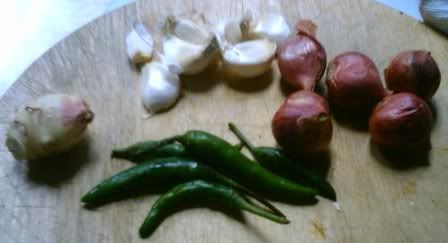
5 shallots
5 cloves of garlic
1 20inch cube of fresh ginger
(all above peeled and slice then grind)
Fish sauce to taste
3 tbps of oyster sauce
1 lime (zest and juice)
1 Tbsp tamarind (soak in some water)
Sugar to taste
Some broth or water
Oil
Garnish:
½ cup unsalted peanuts
1 fistful of chopped parsley (stems removed)
Variations (substitute or add in):
1 boneless chicken breast, sliced thinly, marinated with fish sauce for bout half hour
2 blocks of firm tofu, sliced thinly (I should have added this, I love tofu)
1 egg
Pepper to taste
Fistful of bean sprouts
Banana flower
First soak the noodles in warm water until soften, then drain
Grind up the spices – chillies, shallots, garlic and ginger
Remove the parts of the prawns that you do not like, I left on the shell and tail plus half the head, legs removed of course.
Then heat up the wok in about 3 tablespoons of oil.
Throw in you paste and fry briskly, till the aroma is all over your kitchen.
Then add in the prawns and fry quickly till slightly red
Add in mushrooms, give a quick fry as it wilt quickly
Add fish sauce to taste
Now add in the drained noodles, fry until slightly limp (careful that it does not stick to your wok but still the heat must be high, else it will turn watery)
If using egg, push aside the noodle and crack in an egg, scramble till cook and then fold into the noodles
Then add in fish sauce, sugar and pepper to taste and tamarind plus its water
Then fry some more till a little dry, then lower the heat a little
Add in oyster sauce and stir till combine
Add in the scallions or chives, lime leaves and parsley, stir fry a little more
Off the fire, dish up and serve, garnish with chopped peanuts and more parsley and a lime wedge if needed.
Serves 3-4 people for lunch
Friday, June 09, 2006
Exploring My Origin: Bak Chang
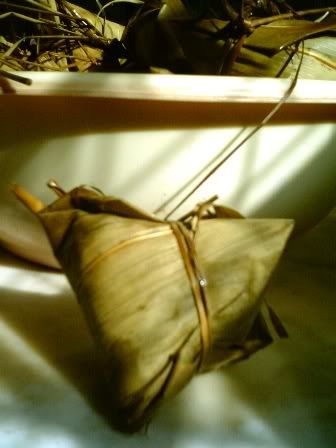
Since young, I had always enjoyed these dumplings, thought it is only quite recently that I learned of the meaning behind it. There are many types of chang (dumpling) made here in Malaysia. The usual ones that I know of is bak chang (which I made this time), which is savoury, and the kan sui chong, which is the sweet type, made plain with lye water and to dip with kaya or coconut caramel. These two are my usual favourites. Bak chang comes in two types, the dark or the white ones. Foodcrazee had talked bout the white ones here. The usual ones that I always had were the dark ones, which is the one I made this time. Bak chang usually have sam chang bak (pork belly), Chinese mushrooms, dried shrimps, either pak mei tau or lok tau (split green peas), salty duck egg yolk and of course, my personal favourite, fong lut (chesnuts).
The process was tedious, as I had expected. But I was adamant to learn and make it; else the tradition and method will be lost. After all, making this dumpling seems like a very good addition to my ‘exploring my origin’ project.
When I got back, I was only half expecting my Lai Ma to make bak chang with me, I had requested since last week, as she is the type who needs to be in the mood to do something. Nowadays, it is up to whether she feels like it or not, or she is tired or not. This time I got lucky, she asked me bout it and then took everything out to prepare. She said she made some before hand and there are leftovers ingredients. The only thing that I needed to do was to walk 5 minutes to the local tim chai (mini store) nearby and get some beans and extra bamboo leaves for wrapping.
So far there are many variations in making this bak chang, but to me my Lai Ma’s bak changbak chang was out and ready to be devour! All I can say is, my cravings had been answered.
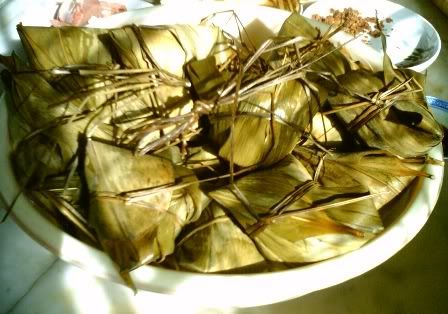
For the recipe, I break down to few parts for easier preparation. Most of the ingredients, especially the spices and flavourings are all in estimation as, I have said, we Chinese cooked by whim, with fingers dipping in and tasting as we go. It is always a splash of this and a dash of that and some jiggling of this and some spoonfuls of that. My Lai Ma said, cooking by taste is one of Chinese secrets to good cooking, as all ingredients we use differ, our own tastes of what is salty and sweet also differ, therefore we cooks know best to tweak to our the situation and our liking.
As for the wrapping, I wish I could be a better artist to illustrate it, but oh well if you still do not understand, you can head on to Teckie to see the video of her mum wrapping the bak chang, she had also written a comprehensive detail of the preparation. Be careful bout the wrapping as either if wrongly wrapped or too loosely tied, it will leak and come unwrap, resulting in a mess that cannot be salvage. We lost one of it (must be the one I wrapped, he-he.
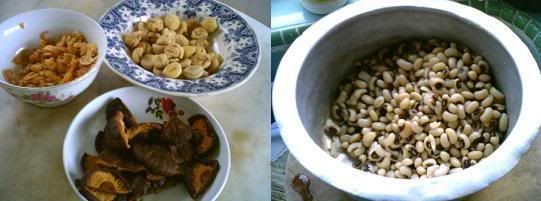
1 kg glutinous rice
800g – 1 kg pork
200g of pak mei tau (not too sure but I guess it is soy bean)
200g (35-40) fong lut (chestnuts) (depending how many you want to put in your dumpling, we have two for each)
8-10 Chinese dried mushrooms (or 16-20 small ones)
Handful of har mai (dried shrimps)
Handful of minced garlic
Additional fillings (I did not add):
Salted duck egg yolk
Hou see (dried oyster)
Lap cheong (dried Chinese sausage)
20 bamboo leaves
8-10 ham choong chou (literally the dumpling weed plant. You can use any string here)
Marinate for pork (in estimation):
2-3 tbsp of five spice powder
Pinch of ajinomoto (I wouldn’t want this but my Lai Ma insists)
Pinches of salt
2-3 tbsp of white pepper
3-4 tbsp of oyster sauce
2-3 tbsp of dark sauce
For the frying the rice (in estimation):
3-4 tbsp of dark sauce
4-5 tbsp of soy sauce (or to taste)
6-8 tbsp of five spice powder
3-4 tbsp of pepper
5-6 tbsp of oyster sauce
Pinches of ajinomoto
Pinches of salt
For frying the fillings (in estimation):
2-3 tbsp of five spice powder
2-3 tbsp of oyster sauce
2 tbsp of pepper
3-4 tbsp of soy sauce

Soak rice with water for at least 6 hrs and up to one day.
Cube the pork and marinate for 8 hrs or overnight
Few hours before cooking and wrapping:
Soak bamboo leaves in water till soft. Then gently wash with running water, wiping with cloth. Stack it up face down in a basin, and then submerge in water until use.
Boil the chestnuts and beans till half cooked.
Soak the dried mushrooms in hot water till soften, then remove stem and halved it (for big ones)
Clean the har mai a few times, running through with water
Drain the soaked glutinous rice.
Cooking the rice:
Heat up 3-4 tbsp of oil in a wok.
Throw in garlic and fried for a minute.
Then add in the glutinous rice and stir fried.
Slowly add in all the frying ingredients, tasting as you go.
Lastly, add in the soy bean, then fry and mix evenly.
Add spices if needed.
Cooking the fillings:
Heat 3 tbsp of oil in wok.
Then add in garlic and stir fry for a minute.
Add in har mai, fong lut and mushrooms.
Fried for few minutes and mix well.
As usual, add in all the fillings spices one by one and fry till evenly mix.
Add in the marinated pork and continue stir fry.
Add in water (bout quarter bowl).
Fry till dry.

Gather 5 strings together and fold it half, then tie a not to form a bundle
Then prepare a place to wrap, something like this:
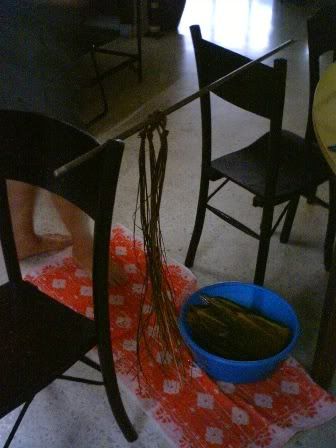

Twist in the middle and turn to shape a cone.
First line the bottom and sides with the rice and bean mix.
Then add in the fillings in the middle: ½ pork, 2 fong lut, 3 har mai and 1 mushroom
Then top loosely with rice.
Turn it upward to close up. Pull it down slightly.
Then turn in and fold the sides.
Fold the top leaves together, then turn down the side.
Now its in a triangle shape.
Tie it with ham choong chou, around the dumpling two times then knot it firmly.
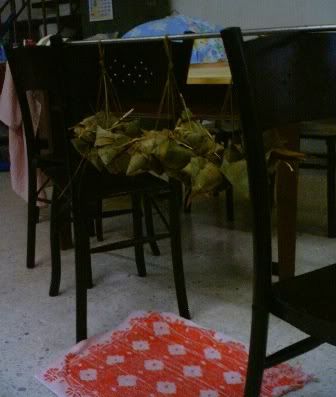
Put in all the tied dumplings into a huge pot of boiling water, submerged totally in the water.
Boil it for 4-5 hrs, topping up with boiling water every hour or so.
Then take out and hang it to dry.
Peel open leaves and devour!

(It can keep for few days or few weeks in the refrigerator)
Monday, March 27, 2006
IMBB 24: I Can Make it in 30 Minutes!
We Chinese fried rice like it is nobody’s business. There is no standard rule, no recipe to follow and every cook fried their rice their own personal way. Our fried rice does not mean just frying the rice, we add in whatever fresh ingredients we have in the pantry. We throw in this and that, whenever we see fits. In other words, fried rice is basically a dump and fried dish, albeit the prior washing and chopping.
In my opinion, fried rice must be originated from those genius housewives that have plenty of leftover rice everyday and came up with ways to make use of it. Cooked rice from last night dinner could be a quick nutritious whip up lunch for today. Whatever fresh leftovers, could be the extra handful of long beans or the two sticks of carrots or the last chicken fillet, can then be used up to make this magical fried rice. Using the leftover rice was actually the key, as I have been told, since the rice is drier and more tough, thus after frying, it will be at the right texture.
In most Chinese fried rice, the basic secret is in the sauce. Yes, the sauce added when we fried the rice. As far as I usually see, there are two distinct types of fried rice, the white ones or the brown ones. For the white fried rice, it could mostly mean the absence of the dark soya sauce, which is usually used for browning in Chinese cooking. It does have taste too; therefore white fried rice and brown fried rice taste somewhat different, but be careful with the dark soya sauce, as too much added, your dish would be bitter. Usually the white fried rice is added flavour with pepper while brown fried rice is usually heavily laden with soya sauce.
As for me, I have never ever fried rice two times the same way. The basic idea is there, but there are always different ingredients, different mixes of sauces thus different tastes. I fried rice numerous times as it’s my trusty quick nutritional whip up of a full meal. Since there are no ‘proper’ recipes for fried rice, in my context, I would just suggest what is there to add into your fried rice, your take.
It is real quick, especially with leftover rice, it could even be in 15 minutes, along with all the preparation, but if not, I’m sure you can cook the rice first, which takes only about 13 minutes. Be careful to add less water/no water as freshly cooked rice are slightly on the wet side, and you do not want a soggy fried rice. Ultimate fried rice has to be fluffy and every grain is separated. So overall, you will have a complete meal in less than 30 minutes!

Chinese fried rice (must haves)
Basic ingredients
Shallots – my grandma taught me this, as it imparts the important aroma in the every fried rice. Always fried the shallots first, till slightly brown, then add the rest of the ingredients.
Onions – in addition or in absence of the shallots, this could be a good substitute. Brown the onions well too.
Garlic – and lots of it I might say, it is one of the essential basic ingredient in every Chinese cooking, I personally like it finely chopped for fried rice
Eggs – it is this is an essential to seal in all the flavours of the fried rice. The secret is to throw it in at the end, mix thoroughly with the fried rice and the flavour is sealed in with extra kick! I learnt this from Ah Ma too, as not all Chinese cook does it, but I believe most of it does.
Meat (making the fried rice tastier)
Meat gives fried rice its sweetness and the full flavour of it. Though not necessary, but with it, your fried rice would be more kingly tasty and of course, the needed protein. Usually one kind of meat is use, in order to maintain its simplicity and not to complicate the flavours too much.
Chicken – boneless chicken are usually sliced and dice into small bite sizes to be used in fried rice. This is the most common meat next to pork.
Pork – a Chinese favourite red meat, really sweet and juicy and totally gives the fried rice a distinct taste. Usually chopped up, or sliced and even roughly minced for some.
Beef – though seldom used but I had ate some in restaurants, something different but nice too.
Prawn – this is actually the secret to a real fried rice fragrance and tastiness. In oppose to what I said, prawn can be added along with any other meat, it is after all seafood, but it serve the same purpose, and definitely do it much better.
Vegetables (personal should haves)
Veggies are good additions to fried rice to add in the nutrition and also making it more complex in tastes, textures and presentation.
Long beans – these veggies pack a good crunch to the fried rice, thus bringing the texture to the whole new layer. It is good for ya and just right with the fried rice.
Carrots – carrots also pack a good crunch to the fried rice. Have it sliced thinly or finely chopped. Not to mention it add good colours to the fried rice. Who doesn’t love orange?
Spring Onions – though I do not always add this in, as I seldom buy it, they come in huge bunch and I just seldom get to finish it. It is usually used for garnishes in dishes, in this case it is a good addition to fried rice, especially good with the brown ones.
Herbs – yes you could add in any herbs you think is right, like fresh Chinese parsley, or basil or even mint. I recently ate J’s mum brown fried rice with mint; it was tasty and refreshing with every bite on the mint.
Sauce (the usual)
Soya sauce – main base for the saltiness in the fired rice. We seldom use salt in this.
Dark soya sauce – to make brown fried rice
Oyster sauce – for the extra kick
Fish sauce – just for taste
Sesame oil – just add a little at the end
Chilli – sauce or sambal or paste, if you want a spicy fried rice
Wednesday, March 15, 2006
Now and Before
Not much cooking nowadays but all workload is starting to lessen. My final year project is soon to be over and then I can concentrate on my finals. Then it is off to the work force for me. Seem really daunting yet exciting. All said I am ready to take on the challenge and start a new journey in my life. We all have to learn to adapt to changes and make the best of it. I am glad I have learned to do so. What bout you?
Before:
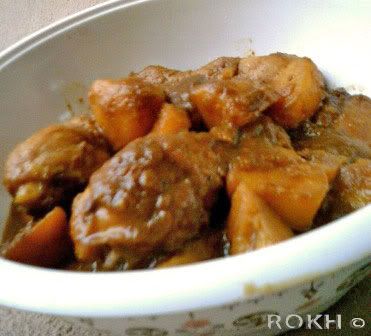
Pongteh (Chicken Stew with Preserved Soy Bean Paste)
This recipe uses ingredients readily available in most households. Chinese households if not. I’m not sure whether many would have the preserved bean paste, which is actually a thick, salty fermented soybean paste. I believe one can get in any asian market easily. Here, it is a must in this dish as it holds the base flavour of it. Gula melaka is actually unprocessed raw palm sugar, easily available in Malaysia. As the name stated, it is originated from Melaka, home of the Peranakans.
As usual, I had left out ingredients to suit my taste (or my pantry) and tweaked the recipe a wee little bit. In the original recipe, one can add belly pork and also shitake mushrooms and yam bean. In the recipe, it calls for first boiling the sauce with the mushroom for 20 minutes. Once again, I took the shortcut, and since I did not use Chinese mushrooms anyway, I only bring it to boil, cut down added water and cooked to a much shorter time.
The recipe noted that it will taste better the next day after the flavors had a chance to infuse into the meat. I for one am not going to compromise this. The overnight dish was great with the meat deeply infused in the taste, which comprises mainly of the bean paste. To me the taste is unique and it is an overall fairly easy recipe. Do try it!
5 chicken drumsticks
3 tbsp cooking oil
Grind to paste:
4 red onions
5 shallots
6 cloves of garlic
2 tbsp preserved bean paste (tau cheo)
600ml water
5 potatoes (cubed)
40g gula Melaka (palm sugar), or to taste
1 tsp of salt
Heat oil and sauté the onion, shallot and garlic paste till fragrant, stirring continuously.
Then add in the bean paste and fry till oil separates. (This did not really happen to mind as I had lowered the oil content considerably)
Add water and bring to boil.
Lower in the chicken and simmer for bout 15 minutes.
Add in the cubed potatoes.
Continue to cook for another 30 minutes or till chicken is tender and potatoes are soft.
Add water if gravy becomes too thick.
Season to taste with sugar and salt
Added: A fellow reader asked me about what tau cheo to make sure she got the right ingredient, so here it is:
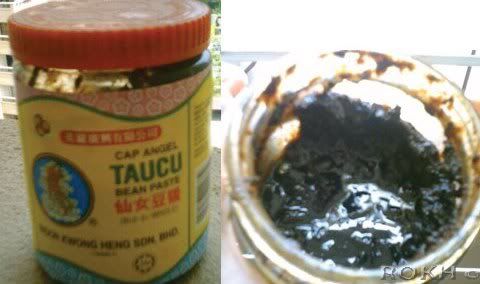
Sunday, January 15, 2006
Smokey Goodness with Rendang
Lemang is actually glutinous rice with coconut milk wrapped in banana leaves then packed into a tube of bamboo and then smoked slowly over fire. Phew, such hard work. This delicacy may be available throughout the year but it is usually full blown with temporary makeshifts stalls everywhere during festivals celebrated by the Malay communities in Malaysia. The usual celebrations are the Hari Raya Aidilfitri and Hari Raya Haji. This Malay delicacy had been highlighted before by Boo from masak-masak. Boo featured lemang from last year’s Hari Raya Aidilfitri, from the same place I had acquired mine. As for Robyn, from EatingAsia, she and Dave had stumbled upon it along the Karak Highway.
This week on Tuesday, it was the Hari Raya Haji celebration. It is known as the Pilgrimage Day of Celebration, which is to mark the conclusion of pilgrimage activites in the Holy Land of Mecca. What luck I have to get my hand on these ‘lemangs’ as I had missed it last year during Hari Raya Adilfitri. Thus, excited like a school kid eyeing a candy, I scrammed on the break and swerved to the left and came to a halting stop by the side of a stall. (Yes, we Malaysians drive like that). Just as I got down from the car, I was greeted by the enthusiastic seller, whose stall I happened to stop right beside. Since it was, as we Chinese like to call it ‘yuin’ (fate) that I got to this stall I decided to get a tube of lemang from them. They even let me sample one tiny piece. Not too bad I might say. I wanted to get their curries but alas, found my wallet insufficient of money. (I had just paid the bills!).
Once I got home, I thrust the newspaper wrapped lemang to J and asked him to guess what it is. J just tore it off out of curiosity (such impatience) and was as excited as I am for the find too. Ah, but what are we to have it with? J, as the Malay cuisine expert here, said lemang have to have with rendang. Rendang, according to Wikipedia, is actually meat curry, cooked in coconut milk and spices for several hours until the liquid dried up, leaving a thick coating of spicy condiments on the meat. Sounds good isn’t it. Not to worry as the recipe is to follow.
Well, as this is also an entry for the Weekend Herb Blogging at Kalyn, I am featuring a herb used in cooking rendang. It is daun limau purut (kaffir lime leaves). These leaves, as the name implied, impart a strong scent of lime and are really refreshing.
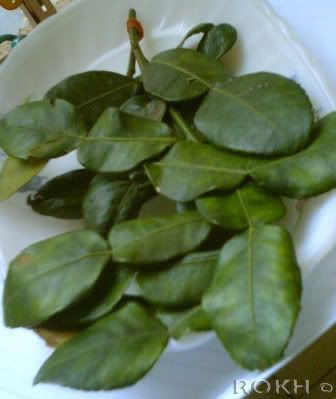
Now let’s go and make some rendang to go with the lemang. Pssst, as I know, it goes well with rice too!
Beef Rendang
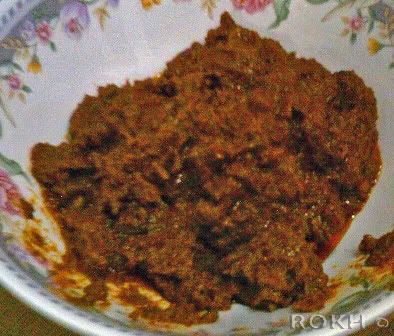
This is my first time trying out a tedious recipe but I was adamant. Yet, I was still pretty lazy and had come up with some cheating methods to fasten up the process. I got this recipe, once again from Amy Beh, but had modified the liquid amount, thus reducing cooking time tremendously.
I was shocked by the amount of coconut milk called for in the original recipe and was further aghast by the idea of adding same amount of water. Thus I reduced it by more than half and had even left out the water portion.
When I got to tesco looking for topside beef, there was none but instead I found packets of cubed beef labeled - beef for rendang. Talk about being 'Malaysianised' eh.
Chilli boh is actually just grinded chillies with salt. Thus, if you cannot get it, I would recommend adding 2-3 sliced chillies to the level of spiciness you desire. Just remember that rendang are just spicy-nice, as in not too spicy yet just a tinge of kick.
Next it was the kerisik (pounded dry-fried grated coconut) which I had no idea where to get, so I improvised and bought desiccated coconut. Then I dry fried the desiccated coconut till brown and then pounded it with my pestle and mortar. (If you don’t have one, maybe you can try pounding with your roller pin or something like that. Think creative!)
Ingredients:
500g beef topside, cubed
Grind together:
4 tbsp chilli boh
7 shallots
5 cloves garlic
4cm piece ginger
2 onions
4 stalks lemongrass, finely sliced
3cm piece galangal
1 tbsp cumin powder
1 tbsp fennel powder
400ml thick coconut milk (1 can)
1/2 cup kerisik (pounded dry-fried grated coconut)
1 tbsp finely-shredded daun limau purut (kaffir lime leaves)
Seasoning:
1 tsp salt or to taste
1 tsp brown sugar or to taste
Method:
Coat bottom of a deep saucepan with a little bit of oil and heat it up.
Add in beef and stir fry briefly till all sides are slightly browned.
Sitr in the ground ingredients and stir to mix.
Then add in the coconut milk.
Simmer over low-medium heat for one hour until beef turns tender and the gravy is quite thick.
Add kerisik and continue to cook until the gravy turns thick and dry.
Add seasonings and daun limau purut.
Stir and cook for further five minutes or until beef gravy is sticky dry
Serves 3 - 4
Thursday, January 12, 2006
Exploring My Origin: Teochew Steamed Fish
Anyway, it had been quite sometime since I share some recipes worth for “exploring my origin” project. I do most of the time cooked Chinese at home, but most Chinese cookery are pretty simple and in terms of ‘agak-agak’ (estimation). As I have said, we Chinese cook on the whim. When we feel like it we add it, when we taste it with our little fingers, oh yes we Chinese are resistant to heat, we would just add whatever our taste bud tells us to. I have countless times seen my mother’s mother, Pho Pho, did the finger thing. She can easily dip in her finger to a boiling liquid and taste it right away. Of course I’ve tried it a couple of times and burnt my tongue without fail. Maybe one day, when I have cook countless Chinese cuisine, I might just be able to act like a seasoned Chinese cook.
The dish that I am going to introduce today is of Teochew origin. As I had mentioned that I am from a Hokkien dialect, Teochew is another one in our numerous Chinese dialects. They used to say that Teochew are considered Hokkien as well. This is because the Teochew are once Hokkien people, migrating south from the Fujian province to eastern side known as Chaoshan. After some influence from the Cantonese and Hakka, they evolved into a separate dialect.
As Teochew people are also quite abundant in Malaysia, we are very much exposed to their cuisine. Teochew cuisines are well known for seafood and vegetarian dishes. They are also in some way like the Cantonese cuisine, cooking with less flavouring thus enhancing the natural tastes of food, while relying heavily on freshness of ingredients. When I go out to eat in Chinese restaurants, I had a few times tasted a very fine Teochew cuisine, which is their steamed fish. I had tried it in many outlets, though it varies a little, but the main ingredients are there and the taste, are simply superb. If you have the freshest of fish, it would certainly be a heavenly dish.
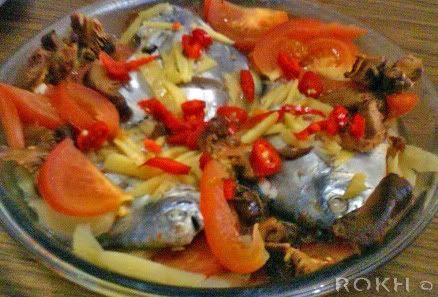
I had used white Pomfret for this dish but had found those large meaty Grouper fishes I had in restaurants are better cooked in this style. It is because in this Teochew way of steaming, one would end up with a pool of wonderful sour-ish soup from steaming the fish which is really good to lap up with big chunks of fish meat. It is to be warned that this ‘assam’ (tangy) taste soup keeps one hungry till the end of the meal. You just can’t get enough of it.
I had modified a recipe from the trusted Amy Beh at Kuali. Her recipe uses sour plum, which I do not have in hand, thus I substituted with some tamarind slices (assam gelugor) and tamarind paste, which I have in hand all the time because it is used in various dishes, such my Ikan Assam. The result is as close to those out in the restaurants, though it varies a little, but still like I say, superb.
Ingredients:
50g salted mustard greens (soaked and shredded)
3cm piece ginger (finely sliced)
1 tomato (cut into thin wedges)
2 black Chinese mushrooms (soaked and sliced thinly)
Mix:
1/4 cup water
1/2 tsp sugar
2-3 tamarind slices (assam gelugor/assam keluk)
2 tbsp tamarind paste
Garnishing:
1 red chilli (cut into strips)
1 stalk spring onions (cut into strips)
1 sprig coriander leaves (chopped roughly)
Method:
Make two cuts on each side of the fish. Rub lightly with salt and pepper.
Put fishes on a metal or heatproof dish and scatter salted mustard green, mushroom and ginger slices on and around the fish.
Pour in the water mixture onto the fish and arrange tomato slices around fish.
Steam fish over rapidly boiling water for 12 to 15 minutes or until the fish’s eye popped out. (This is an indication that the fish is cooked.)
Garnish and serve the dish steaming with hot soup!
Serves 4
Thursday, January 05, 2006
Double Cheers For The New Year
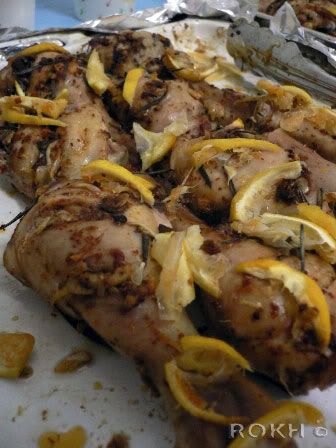
Spaghetti Bolognaise with asian twist of rich chicken stock and less tomato:
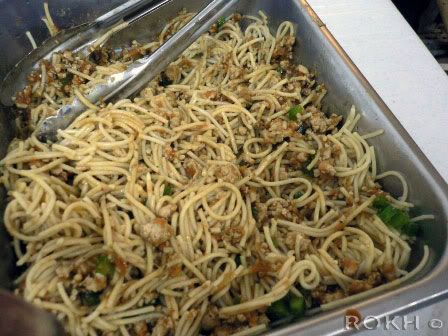
The special Char Chee Cheong Fun (it is hard to take a picture of this black mess but trust me, it is really delish!):
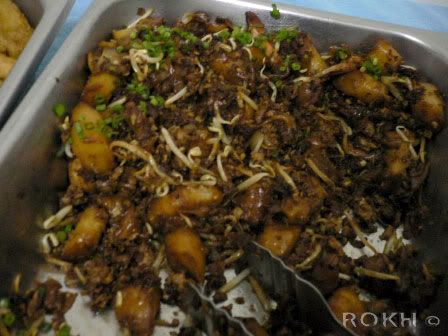
And now for the
Potato Salad
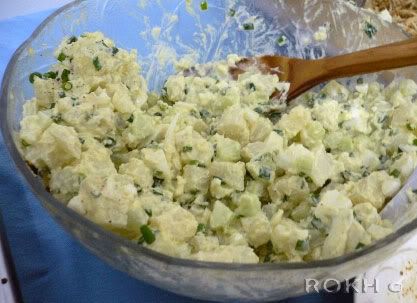
2 bunches of spring onions
3 cucumbers
10 eggs (hardboiled)
A small jar of mayonnaise (bout 200mk)
Salt and pepper to taste
Cut into cubes the potatoes, cucumbers and hardboiled eggs.
Then chop spring onions finely.
Put all in a large mixing bowl and stir in mayonnaise.
Add salt and pepper to taste.
Serve a party of 20-25 people
Wednesday, January 04, 2006
Cheers For a New Year
I did not get the entry in early enough because the owner of the camera, my friend, who had not sent me the pictures yet! Well, I had to fill in and post up the preparation for my chicken first. The rest of the readied yummy food will follow, by tonight, hopefully. I swear to wring my friend’s heart out if she does not send me the pictures tonight.
New Year started for everyone and a new semester started for me. Well, after enjoying, playing and of course cooking and baking for whole three months, it is time for me to settle down and do what I need to. I will still be posting for sure, but of course, much shorter ones. I love to write, but time is always the limit. I love to research and share knowledge with the world, but again, time and resources is limited.
This year, I celebrated with J in my friend’s place. There is not much variety of food but yet all of it is scrumptious. We had catered for the spaghetti bolognaise, which was rich with chicken stock, not the usual tomato-ey fare but still very scrumptious. Then we had a local flavour of Char (fried) Chee Cheong Fun, which is basically large flat rice noodles rolled up. The usual fare is to serve these with sweet or spicy sauce but as usual, Malaysian loves to fusion recipes to make it our own. If I am not mistaken, these are originated from Hong Kong, commonly known as Cheong Fun. For this Char Chee Cheong Fun, it is actually frying the Cheong Fun like how we would for Char Kway Teow, literary also fried flat rice noodles. Then there was the potato salad, made by my long time friend from Taiping, which was really delish. I had requested recipe from her and of course would be sharing with you guys then. I could not possibly keep good eats to myself, can I? Then there was also some fried frozen nuggets and popcorn chicken. Dessert was canned sea coconut (sleeve palm), yes canned, according to my friend we are suppose to relax and enjoy the New Year, so no working our neck out. After roasting 30 chickens, I could not have agreed more with her. As for me, my humble contribution to the party was
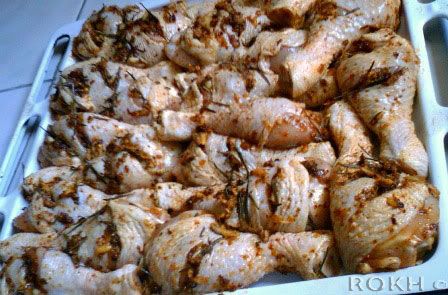
Roasted Rosemary Paprika Chicken
I adapted this dish from a cookbook, but as the usual me, I had trouble following recipes diligently, especially when it comes to cooking. Baking, I might still be a good school girl and not bold enough to twist recipes, but cooking, ah, we Chinese cooks by feel and taste. Try getting recipes out of seasoned Chinese chefs and they would be telling you like, throw in a little of that, then a lot of that, a bunch of this and a handful of that. It is then up to you to improvise, judging for what you had eaten. Usually, it is easy, if you had been eating it most of your life.
As for this recipe, after much tweaking, I find the taste slightly too mild. Maybe I was looking for punch on the spice. Luckily it was saved by the rosemary. I used fresh ones, which does make a lot of differences from dried ones. I pounded the spices on my good ol’ pestle and mortar which I loved a lot. It was from my nanny, a small one but well seasoned. If you do not have one, then just grind the ingredients, but be careful not to make it into a paste.
There was a tip from the cookbook which said that roasting chicken in a non-preheated oven produces crispy skins. It was a little crispier then the previous ones which I roasted after preheating, but I still prefer the method of browning it first before roasting, which produce not only crispier skin, but also more delicious looking roasted chickens. Alongside, I had also roasted some carrots, shallots and whole garlic cloves tossed with olive oil, pepper and salt.
30 drumsticks
Pound/grind:
12 garlic cloves
3 tbsp of paprika
2 tbsp of hot chile pepper
5 sprigs of rosemary (stripped)
2 tbsp coarse black pepper
3-4 tbsp of olive oil
Juice of 2 lemons
Salt to taste
Put together ingredients and pound/grind the spices together.
Clean the chicken and cut out visible fats. Then score two huge slits on the thick part.
Rub spices onto the chicken, and try to stuff those yummy stuffs into the slits.
Line up drumsticks on roasting pan.
Squeeze lemons all over chicken.
Slice the squeezed out lemons thinly spread all over the chicken.
Put it into the oven and left to marinate for 2-3 hours.
Sprinkle salt over the chicken.
Roast chicken in 200C/400F/Gas 6 oven for 1 – 1 ½ hours.

Friday, December 30, 2005
From My Rasoi: Kheema
Winter is a tough theme for a tropical gal like me. In Malaysia, it is either rain or shine here. When it is hot here, it can be burning hot. You would not want to be caught out in the sun especially right at noon. In fact, you can have burning sensation on your head. During my high school days, I was a school basketball players and fanatically, we play till 11am when the sun is high and our head is about to set on fire. Although it is really hot around, we are still lucky as the air is humid and never too dry plus we get a fair share of rain all the time. In Taiping, as I had mentioned as the wettest town in Southeast Asia, I had countless times of enjoying the cooling rain while I sleep.
Sometimes I do wish for four seasons like other countries, where we can enjoy the sun in the summer, catch fallen leaves in autumn, throw snowballs at winter and enjoy rebirth of nature in spring. But sometimes, I revel in the fact that we have consistent weather and nothing to worry about, just maybe occasional floods.
So therefore, my interpretation of the theme may vary a lot from people but I feel, as for winter, it is a cold time calling for hot food! Coincidently, all Indian food is hot! And I meant not just the high heat but spicy and exciting.
As for me, this month I will be featuring a really delectable dish that was introduced to me in a recent food gathering. As I had mentioned a few times, I am actively involved in a Singapore/Malaysia food forum Kitchen Capers, where we had organized a meet up, joint with another local forum that I was recently introduced to - Jo’s Deli, last month for both Malaysian members. There, a member had cooked up a delicious and ‘never get enough of’ dish – Lamb Kheema. Oh it got me dreaming of it day and night after the gathering. So, naturally, when everyone posted up their recipes, I try this one out first straightaway.
Kheema is a hot dish which is not too spicy but yet do not lack in taste. It is really complex in flavours although the ingredients are pretty simple and I am quite sure, readily available. According to Wiki:
This is a traditional Punjabi home cooked dish and is popular with northern Indian/Pakistani people in the Midlands. It is minced lamb curry served with
peas.
Meena had also cooked up some Keema Matar, with ground chicken and peas. I totally agree with her on the part about peas, as I personally feel it is the main ingredient that made the dish at the right texture with the right taste. Not to mention it adds more colour to the dish and of course, more nutrition. Now, without further ado, let me introduce you this hot dish for cold times or to level your winter, if you are in one.
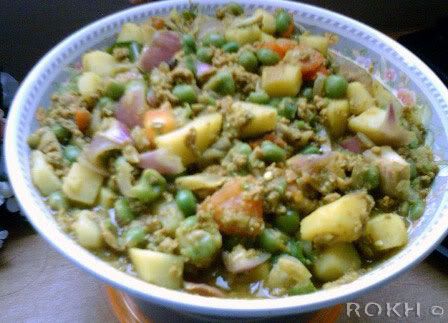
Kheema
I had used ground pork for this dish but found that the lamb that I had in the gathering had much more complex taste, but nonetheless this was also really tasty. This is a simple yet wonderful dish, certainly a keeper in my rasoi!
Grind to a fine paste:
4 slices of ginger (each 1 cm thick)
3 cloves of garlic
250gm minced meat (lamb, beef, chicken or pork)
3-5 tbsps of curry powder (according to level of spiciness)
2 cups of water salt to taste
120 gm green peas (I used 1 can)
1 green chilli (thinly sliced)
Cut into cubes:
2-3 medium sized potatoes (peeled)
2 tomatoes
1 big onion
For frying:
1/2 onion (thinly sliced)
3 cardamoms
4 cloves
1 stick cinnamon - about 4cm long
In a bowl, mix the meat with ginger-garlic paste, curry powder, salt and ½ cup water.
Then heat oil in pan and fry the ingredients for frying.
When onions are soft, add the mince meat and fry till fragrant.
Add the potatoes and stir in 1 ½ cup of water. Bring to boil. Cover and cook till potatoes are soft, stir occasionally.
Then add cubed tomatoes and onions, peas, chilli. Cover and cook for another 3-5 minutes.
Dish out and devour!
Serves 4
Sunday, December 18, 2005
Weekend Herb Blogging - Lemongrass
No matter how busy one is, we always have time for food. The first thing we thought of when we wake up is what to have to break the fast. It might not be breakfast, as sometimes (or usually) I break my fast with lunch. Ah, lazy me. Then in due time we would be thinking what to have for dinner. Such gluttony! But aren’t human born to live like that?
Anyway, to keep this post short and to rumble back to my busy dailies, I would continue on about the main thing you must be asking, “Where is the herb?” Pardon my long windedness, so here goes this week’s herb, Lemongrass (Serai).
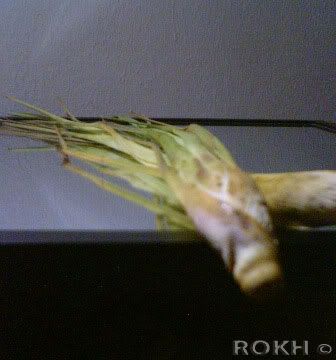
This particular herb is featured mainly in Thai, Malay and Nonya cuisines, giving an instant lift to any food. Lemongrass is one herb that leaves a sweet lemony smell to your fingers after you cut it and it will instantly jazz up your spice mixes once grinded or pounded to release the aroma. It is widely used especially in cooking curries, soup (like the famous Thai Tom Yum soup that relies practically on this herb) and other spice mixing recipes. It can also be used in making of drinks like tea or honey. I once had honey lemongrass drink with the herb stalk itself used to stir the drink, exotic and certainly refreshing.
The recipe that I will be showing using this sweet herb is from the Nonya cuisine. Nonya is basically the people from the marriage between the Chinese and Malay, creating a new generation of Peranakan. Although they are half Chinese, these Peranakan had adopted Malay culture wholly with a little of their own influences, causing a new hybrid of culture that they call their own. These generations of people are prominent from Penang and Malacca but it is in Malacca that is left with many remnants of it. When one culture is created, most certainly a new cuisine of its kind emerged. Nonya cuisines are fusion of Chinese and Malay cuisines with Thai and Indonesia influences. There is an extensive explanation of Nonya cuisine over at Malaysian Food, if you are inclined to know more.
Well, I suppose this following recipe of mine must be of Thai influence with the usage of lemongrass, and it is a little bit spicy with a strong smell of belachan(shrimp paste), another acquired taste food. When frying the belachan, one is bound to be caught up with the strong aroma rising which would choke right up the nose, down the nasal to the throat. I’m not kidding here! I can still remember the days when my Nanny cook up a storm of Sambal Belachan (chilly fried with belachan paste), the whole house would be choking in the strong aroma. But secretly we would be smiling with glee anticipating what would appear on the dinner table next. Well, after a nasal war just now, I whipped up a sour fishy Nonya dish.
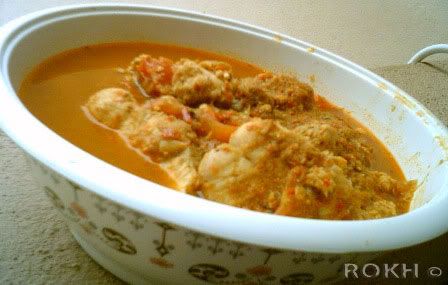
Ikan Assam (Spicy Fish in Tamarind)
Source: Female Appetite (Edition 1)
I did not have ginger flower and had omitted eggplants and lady’s fingers, adding more tomatoes instead, but I guess with those, it would had been much more flavourful and of course much more colourful. I ran out of lime thus added more tamarind for the sourness. I had also added 1 inch of Galangal (Lengkuas) just for fun, as I feel it would be appropriate, ah a cook’s whim.
4 tbsp oil
15g tamarind paste
500ml water
1 eggplant, julienned
1 tomato, cut in wedges
4 lady’s fingers
400g fish fillet
2 tbsp lime juice
Salt and sugar to taste
To grind:
30g dried prawns
20g shallots
30g onions
2cm belachan (shrimp paste)
20g dried chillies
20g red chillies
1 stalk lemongrass
1 stalk ginger flower
Heat wok over high flame, add oil and lower the flame.
Sitr in grounded ingredients and tamarind paste until aroma arises
Add water and bring to boil
Reduce heat and add eggplant, tomato and lady’s fingers. Cook for about 10 minutes before adding the fish.
When fish is cooked, add lime juice, salt and sugar.
Serves 4 - 6 (depending on edacity of guests)
Note: This spicy dish tasted much much better overnight (we got plenty leftovers) and reheated, the complex flavours developed more and had taken it to a whole new level. So next time, I would cook it and leave it soaking at least few hours first before devouring.
Update: Check out the list of herbs for this week over at Kalyn's.
